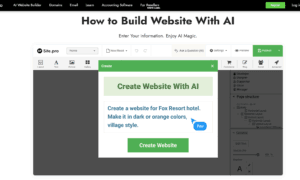Keeping a website in good shape takes more than just hitting publish. Without the right systems, even simple tasks like updating content or checking performance can turn into unnecessary work. The good news is, most of the friction, those extra steps and slowdowns, come from poor setup, not from what you know.
By making a few smart adjustments early on, you can simplify daily operations, reduce maintenance overhead, and stay focused on growth instead of busywork.
1. Choose the Right Content Management System
The platform you choose directly affects how easy your website is to manage. In most cases, that platform is a content management system (CMS). It is a backend tool you use to create, edit, and organize content without manually coding pages. It handles the structure behind your site so you can focus on publishing and updates.
Beyond the basics, a well-designed CMS should make it easy to adjust page layouts and manage site-wide settings with minimal friction. The less you rely on technical help for routine updates, the more efficiently your site runs.
If you’re building something more tailored, such as a large-scale business site or one that relies on structured workflows, a more advanced solution is often the better fit. A platform like BCMS offers greater flexibility, developer-friendly architecture, and smoother integration with other systems. It’s built to handle performance, scalability, and custom workflows with more precision and control.
- Monitor Website Performance Regularly
A big part of managing a website effectively is knowing how it’s performing. If you’re not tracking speed, traffic, or technical health, you could miss serious issues or opportunities for improvement.
Use performance monitoring tools like Google Search Console, PageSpeed Insights, or GTmetrix to keep an eye on how fast your pages load, how your site performs on mobile devices, and whether there are crawl errors or broken links. Slow load times and unresolved technical problems can frustrate users and hurt your search rankings.
Set a regular schedule, weekly or monthly, to review key metrics. This not only helps catch problems early but also guides smarter decisions about content, design, and development. A site that runs well is much easier (and more rewarding) to manage over time.
3. Implement a Clear Site Structure and Navigation
A messy website isn’t just hard for visitors to use, but it’s also harder for you to manage.
Start by organizing your site with a clear structure. Group similar pages under logical categories. Keep your navigation menus simple and straightforward. If you have a blog, use tags and categories to keep posts organized. For e-commerce sites, make sure products are sorted by type, brand, or use case.
A clear structure also helps with SEO and makes content updates easier. You won’t have to dig through pages to find what you’re looking for, and your visitors will appreciate being able to find things without getting lost.
4. Create and Follow a Content Calendar
Keeping your website up-to-date is important, especially if you run a blog, post news updates, or publish case studies. But without a plan, it’s easy to fall behind or forget to post regularly.
That’s where a content calendar can help. A simple spreadsheet or calendar app like Google Calendar, Trello, or Notion can be used to plan what content you’ll publish and when. You can also track who’s writing each post, when drafts are due, and when updates go live.
Following a calendar helps you stay consistent and avoid last-minute scrambles. It also gives you time to review, edit, and improve content before it’s published.
5. Automate Routine Tasks
There are lots of small but important things that need to happen behind the scenes of a website, like running backups, checking for broken links, updating plugins, or sending follow-up emails. Doing these manually every time is a waste of your energy.
Automation tools can take care of these for you. For example:
- Use a plugin to schedule automatic backups.
- Set your CMS or hosting platform to install updates automatically.
- Connect your contact forms to your email list using tools like Zapier.
- Use services like Uptime Robot to monitor your site and alert you if it goes down.
Automating these repetitive tasks keeps your website running smoothly and gives you more time to focus on what matters—whether that’s writing content, growing traffic, or managing your business.
6. Standardize Your Design and Content Elements
Design consistency isn’t just about looking good—it also makes managing your site much easier.
Instead of designing every new page or blog post from scratch, create reusable templates. This could be a blog post layout, a landing page format, or product description blocks. Most modern website builders and CMS platforms allow you to save and reuse templates with a few clicks.
You should also use consistent headings, fonts, and colors across the site. This not only gives your site a professional feel but also speeds up the editing process because you’re not making design decisions every time you add a page.
A simple brand style guide can help you and your team stay on the same page with tone, language, and visual elements.
7. Maintain a Plugin and Integration Inventory
Plugins, scripts, and third-party tools are great for adding features to your site. But the more you add, the harder it can be to keep everything running well.
Over time, old plugins can slow down your site or cause compatibility issues. Some might even pose security risks if they’re no longer updated by the developer.
Make it a habit to review your plugins and integrations every few months. Remove anything you’re not using. Update what’s out of date. And avoid adding unnecessary tools just because they look cool—if it doesn’t serve a purpose, skip them.
Keeping a simple list of what each plugin or tool does, who added it, and when it was last updated can save you a lot of trouble down the road.
Managing a website doesn’t have to be complicated. With the right setup, a bit of planning, and some helpful tools, you can make your site easier to run and maintain over time.
Pick one or two of these tips to start with, and you’ll notice the difference right away. The easier your site is to manage, the more time you’ll have to focus on growing it.



































